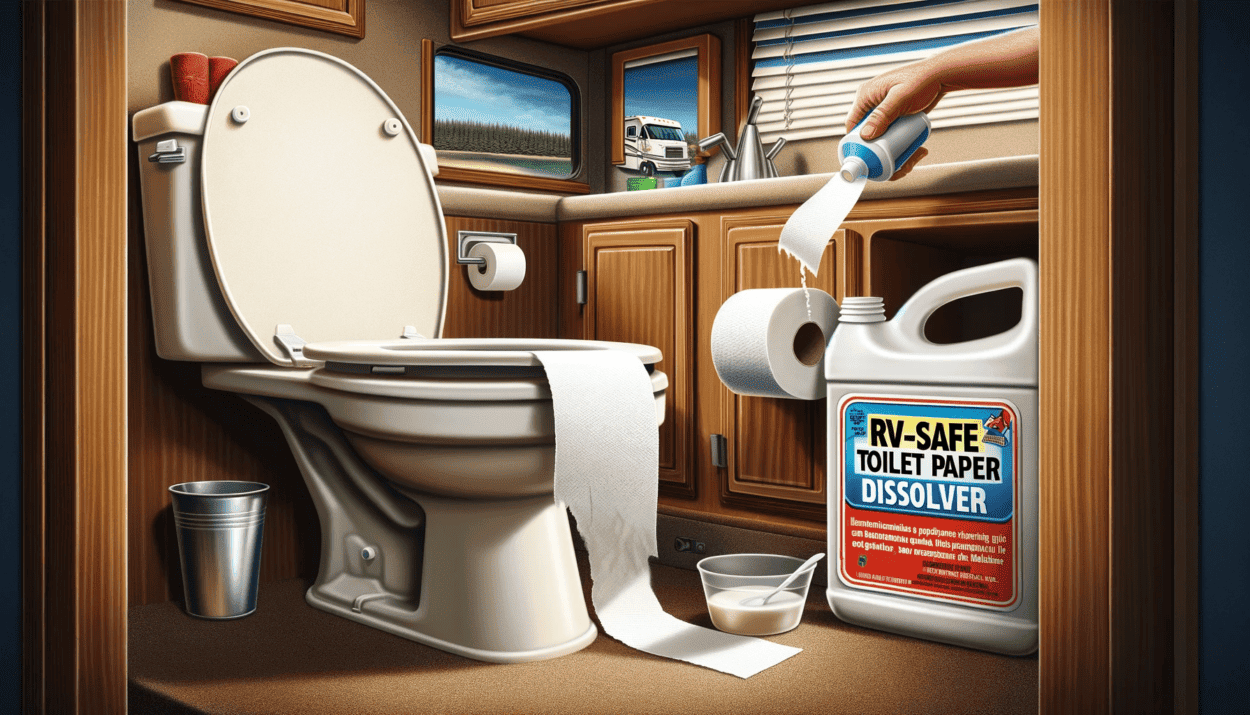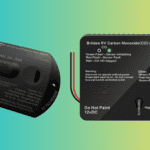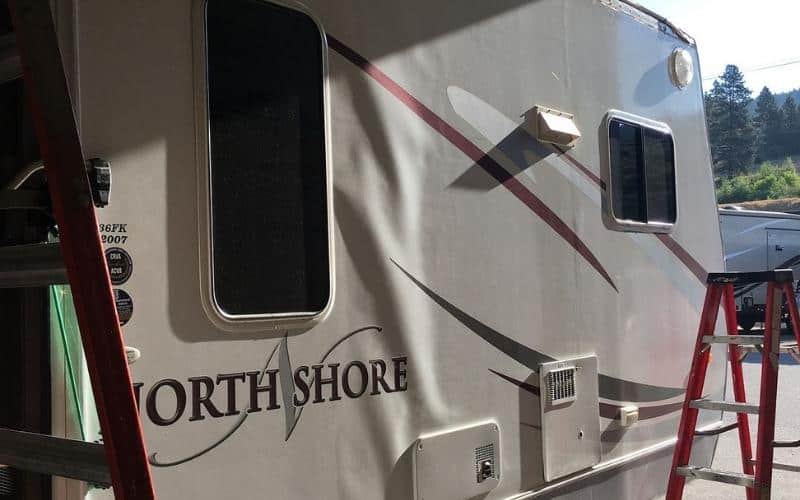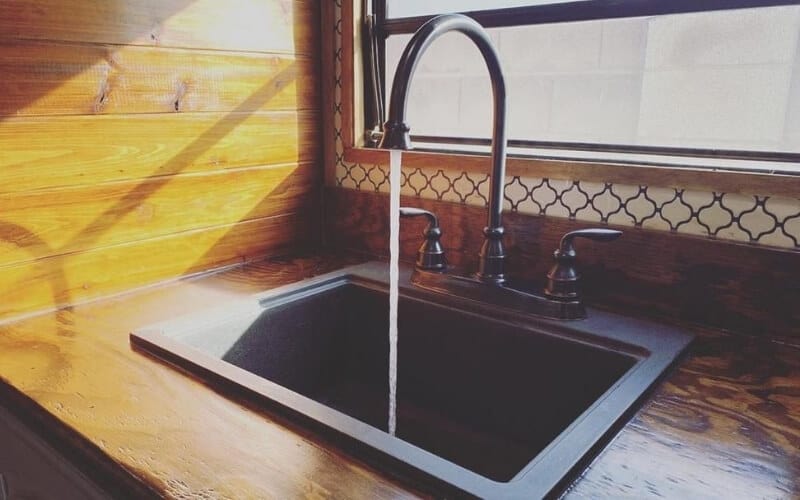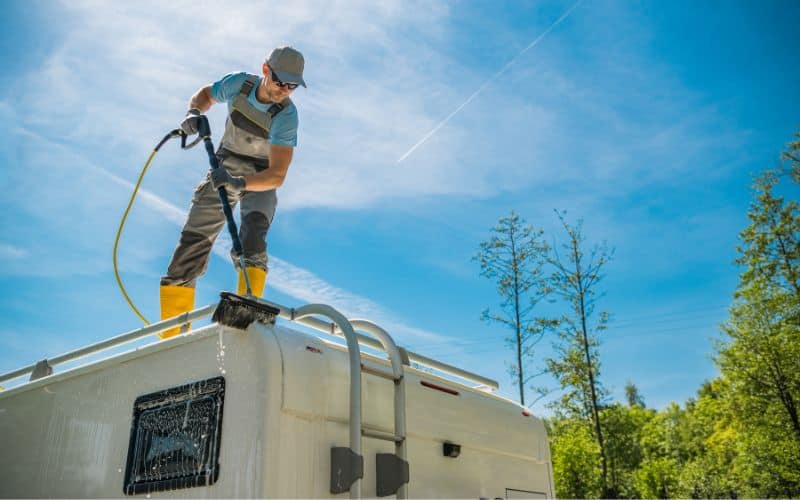Dissolving toilet paper in an RV holding tank or pipes is straightforward with simple tips. Using hot water, chemical digesters, a tank wand, and extra flushes, you can liquefy toilet paper and stop clogs fast.
I’ll never forget when we were midway through a cross-country road trip in our RV when we encountered the dreaded clogged black tank. Since then, I’ve discovered how to dissolve toilet paper in an RV toilet and keep things flowing freely. These DIY methods have helped me avoid nightmare clogs ever since.
With my tips and tricks, you can say goodbye to clogged tanks and frustrating toilet issues. I’ll also answer some frequently asked questions at the end. So read on to level up your RV toilet knowledge!
Causes Of RV Toilet Clogging
RV toilets are more prone to clogging compared to residential toilets. The compact, low-flow RV toilet systems are prone to obstructions from toilet paper, waste buildup, and other issues. By understanding what causes clogs, you can take steps to prevent frustrating backups.
| Cause | Explanation |
|---|---|
| Using domestic toilet paper | Low-flow RV toilets can’t always clear single-ply toilet paper, leading to a buildup in the toilet trap. |
| Solid waste buildup | Solid waste accumulates in the black water tank, forming a pyramid plug obstructing the toilet outlet. The entire black tank isn’t necessarily full, but the area of the tank directly under the pipe draining from the RV toilet might be blocked by the tip of solid waste accumulated in the form of a pyramid. |
| Infrequent dumping | Letting the black tank (a container on the underside of the RV where the RV toilet drains) get too full can cause solid waste to back up in the toilet’s outlet pipe. |
| Lack of tank maintenance | Neglecting tank maintenance allows residue to accumulate on tank walls, narrowing the pipe and impeding flow. |
| Foreign objects | Non-biodegradable items can get stuck in narrow waste pipes or valve openings, causing clogs. |
| Pipe obstructions | Mineral deposits, grease, or debris in the discharge pipe can block waste passage and restrict flow. |
| Faulty valves | Worn-out blade valve seals under the toilet can accumulate solid waste and get clogged, resulting in impaired drainage from the RV toilet. Malfunctioning black tank gate valves can also lead to leaks and blockages in the system. |
| Using too little water | Inadequate water volume in low-flow RV toilets can result in poor flushing and an increased risk of clogs. Pour 1-2 gallons of water to keep the system flowing. |
How To Dissolve Toilet Paper In An RV Toilet
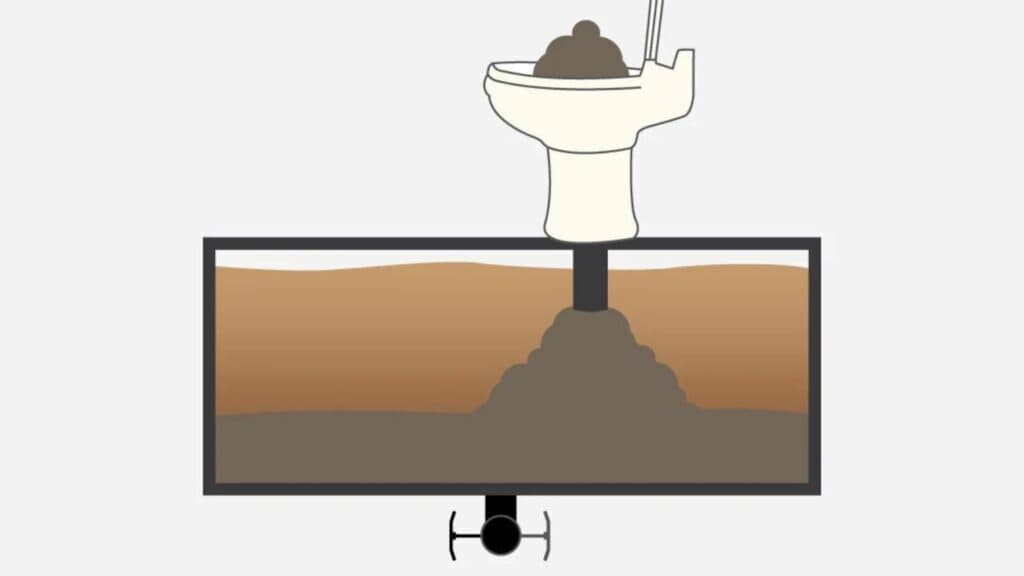
A Pyramid Plug: Source
Here are tips on how to dissolve toilet paper in an RV toilet and keep things flowing smoothly.
Add Boiling Water
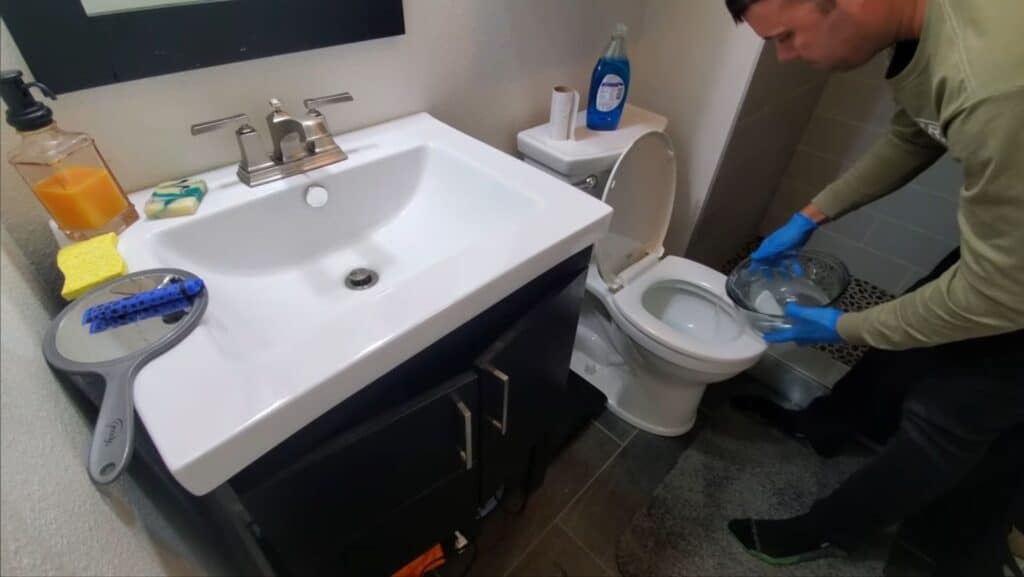
Adding hot tap water to a clogged RV toilet: Source
Use boiling water to dissolve wadded-up toilet paper, causing an RV-clogged toilet. Boil the water on the RV stove. Carefully pour 2-3 pots of hot water directly into the toilet bowl.
Let the boiling water sit in the bowl and penetrate the tank and the discharge pipe for 15-30 minutes. The hot water will soften and dissolve stuck clumps of tissue paper. When you flush again, the water often breaks down the clog enough to pass.
Use Chemicals
If boiling water fails to do the job, you can use vinegar and baking soda to solve a clogged camper toilet.
- Pour vinegar into the toilet. It acts as a mild cleanser and starts the tissue paper breakdown.
- Next, pour down one to two cups of baking soda. Wait for 10-15 minutes and regularly flush the toilet.
- Then add baking soda again and repeat the process until the toilet unclogs.
- Mix one cup of vinegar with two cups of dishwashing liquid, make a paste, pour that down the RV toilet, and regularly flush the toilet to eliminate the clog.
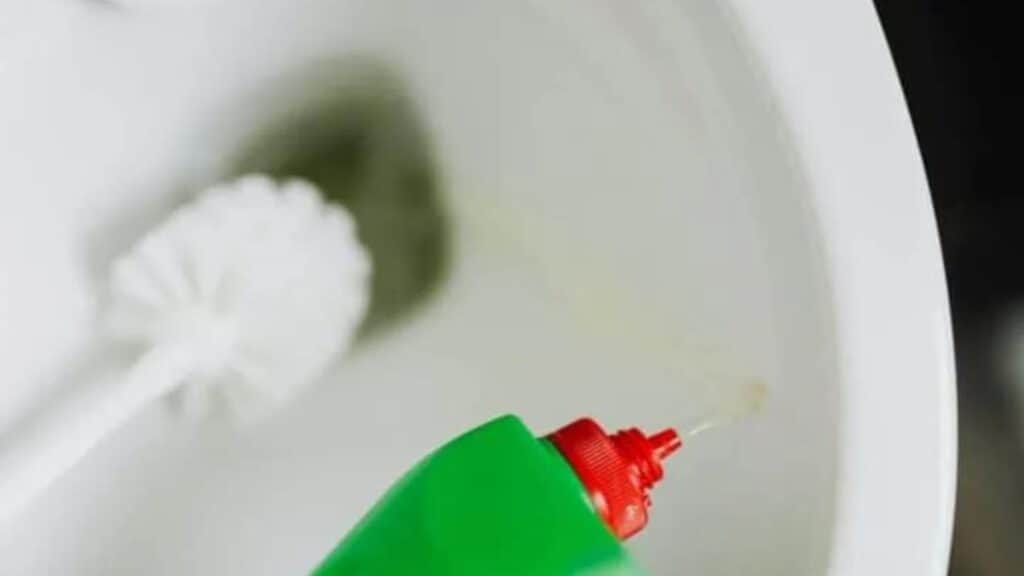
Source
Use A Tank Digester
We’ve entered the domain of stubborn toilet paper accumulations that won’t break down by pouring hot water and using chemicals. Products like Unique Digest-It, Happy Campers Holding Tank Treatment, and Valterra TST Waste Digester contain chemicals and enzymes that dissolve toilet paper and waste.
Simply add some down the toilet bowl per the package directions. Let the cleaner sit for at least 24 hours before flushing again so the components have time to work. The clog should wash away after time for the enzymes to take effect.
How To Prevent A Clogged RV Toilet
I always stick to the following basics to prevent my camper’s toilet from clogging or immediately remove the clog.
Use Dissolving 2-Ply Toilet Paper
Some RVers try to save money and buy single-ply toilet paper rolls for residential use. While super cheap, this thin single-ply paper breaks apart too easily.
Investing in a quality RV 2-ply toilet paper prevents most of these issues. Brands like Scott Rapid-Dissolving, Thetford Aqua-Soft, and Camco RV TP are more suitable for low-flow RV toilets.
The 2-ply is strong enough not to fall apart into shredding pieces. However, the texture and composition still allow it to dissolve rapidly when flushed with only 1-3 gallons of water. This toilet paper breaks down entirely instead of forming small pieces and keeps waste pipes clear.
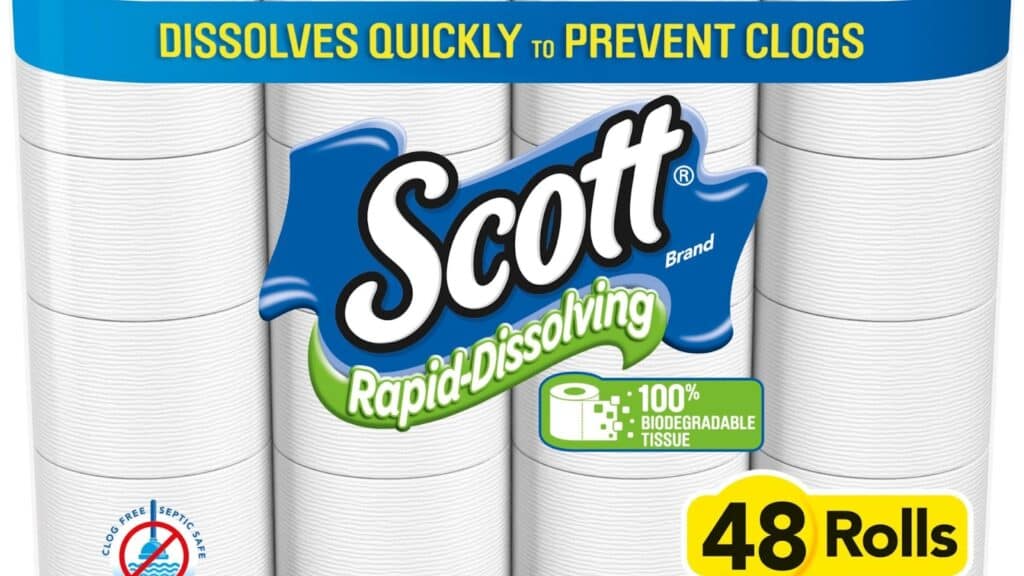
Install A Backflush System
The Backflush system forces water into the tank to help dissolve and dislodge debris. The backflush kit connects to the outlet valve of your black tank.
Turning on the water feeds fresh water backwards into the tank. This added agitation helps dissolve accumulated toilet paper and breaks apart solid obstructions. It also rinses away biofilm buildup.
Backflushing is an easy way to deep clean the tank interior without chemicals. For severe toilet paper accumulations, try backflushing for 5-10 minutes at a time. This keeps the tank fresh and helps prevent significant clogs.
Use More Water When Flushing
RV toilets operate on limited water, which can cause shredded toilet paper solid waste to accumulate. If your RV toilet uses only 1 gallon per flush, try pouring 2-3 extra gallons of water directly into the toilet when you flush. Read here to know about different types of RV toilets, and how much water does each type use.
Keep The Black Tank Valve Open
The black tank in an RV holds all the waste from the toilet. A gate valve at the bottom of the tank opens to empty the contents. Many people leave this tank valve open while driving or hooked up at a campsite, assuming it’s fine because the waste goes into a sewer hose.
However, keeping the valve open causes problems. When the valve is closed, the movement of driving or people walking around the RV creates agitation inside the tank. This agitation helps break down toilet paper and solid waste by mixing it around.
With the valve open, there is no agitation because the contents simply drain out. This allows toilet paper and waste to accumulate on the tank walls and potentially clog. So, for proper operation, keep the black tank valve closed except when you need to open it briefly to empty the tank completely at a dump station.
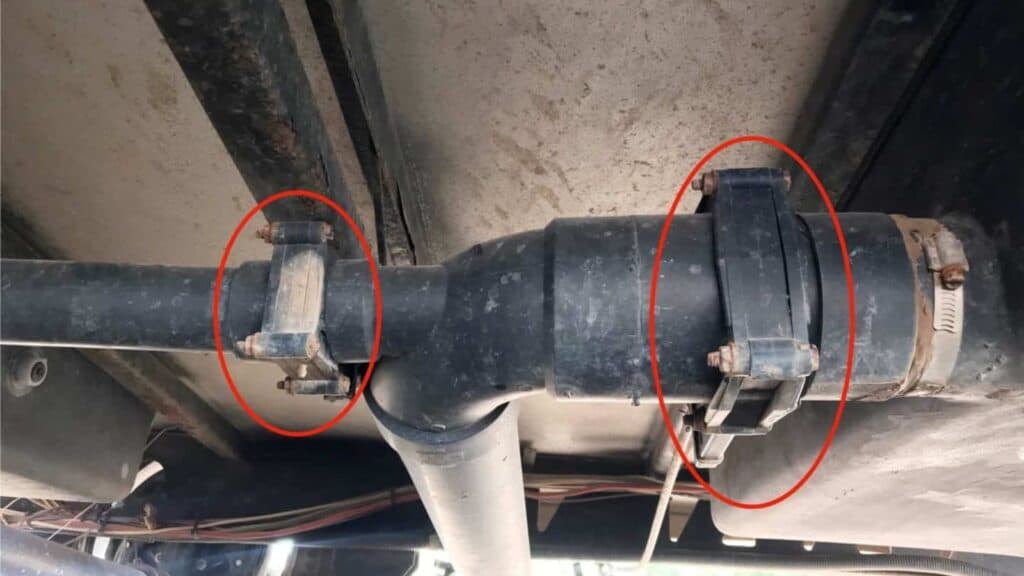
Source
Dump Tanks Frequently
Make it a habit to empty tanks regularly at 2/3 capacity or every 4-5 uses. Monitoring tank levels with a digital meter and dumping frequently prevents toilet clogs.
Screen Black Tank Intake
The screen fits onto the toilet outlet and acts like a filter. It catches all the debris, hair, and particles that try to go down into the tank. Without a screen, these pieces of debris can get stuck in the tank pipes and clog things up.
Brands like Valterra and Camco make small screens that attach easily between the toilet and discharge pipe. The screen attaches with basic hand tools in a few minutes. All the waste then flows through the screen to the black tank. Anything too big gets caught before it can cause a clog. It’s an easy add-on that helps avoid headaches down the road.
How To Unclog An RV Toilet Immediately
Whenever you see that your camper’s toilet is clogged, immediately follow these steps to prevent more significant issues in the future:
Use a Plunger
When you notice a toilet clog, an RV plunger is the first tool to grab. This specialized plunger has an extra flap to seal against the oval RV toilet drain opening. Regular household plungers usually won’t form an airtight seal on RV toilets.
With the plunger sealed over the drain, vigorously plunge up and down 15-20 times in quick bursts. This rapid plunging pressurizes the waste line, helping to dislodge the clog. The key is creating strong suction and pressure repeatedly.
Continue resealing the plunger and plunge again if needed. The force surges should eventually dislodge the debris enough that water can pass freely. Flush again to confirm you cleared the obstruction. If water still drains slowly, move on to the following unclogging method.
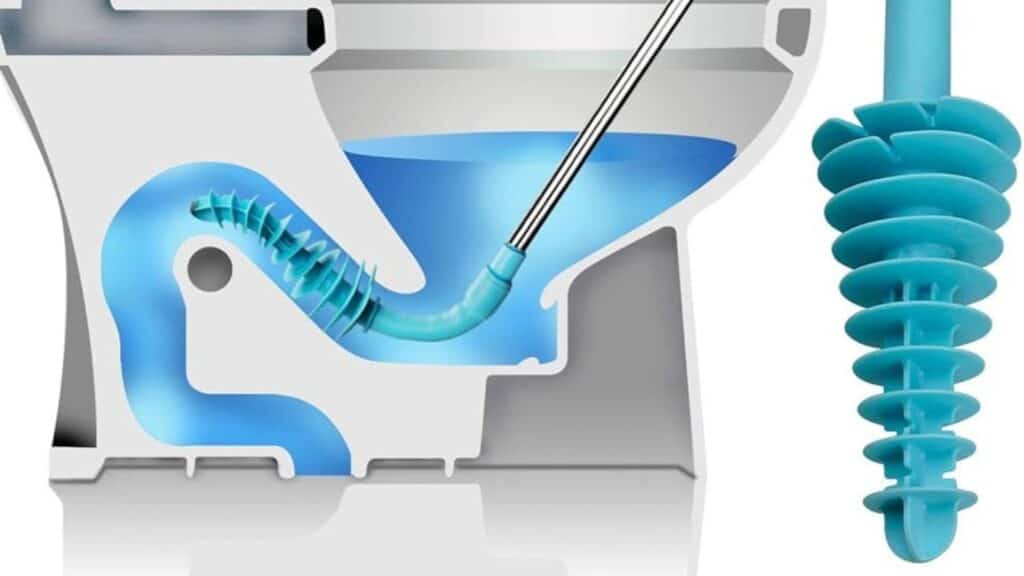
Employ A Tank Wand
If plunging fails to open the line fully, a tank wand is your next weapon. This specialized tool connects to a garden hose and lets you blast pressurized water directly into the black tank. Insert the narrow wand through the toilet bowl and deep into the tank.
Position it towards the rear of the tank or directly down into the toilet drain opening. Then, open the water valve to engage the high-pressure jet. The forceful spray will scour the tank walls and pipe interior, propelling out any debris.
Repeatedly reposition the wand and blast from different angles to cover all surfaces. This should knock loose any toilet paper, waste, or obstructions. Flushing the toilet again after using the wand should now allow free drainage.
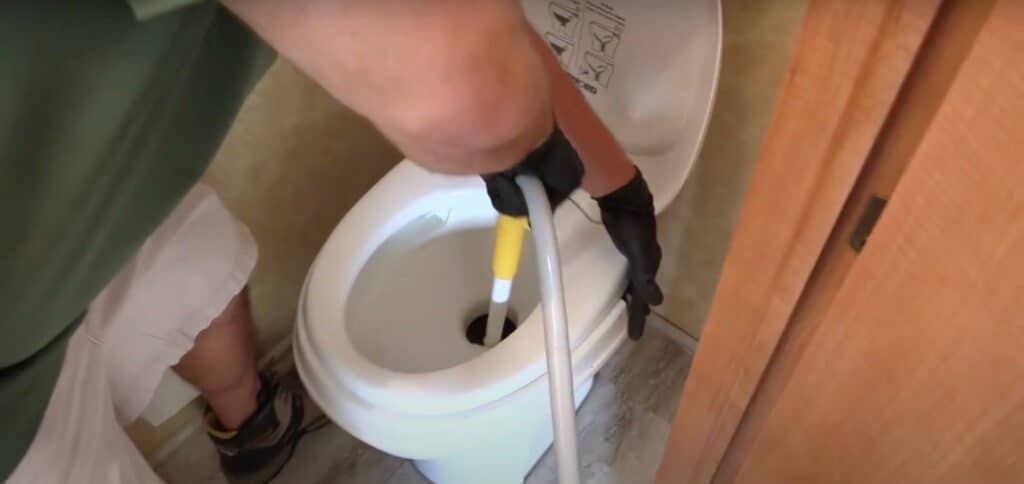
Pour Boiling Water Or Use A Chemical Cleaner
I’ve already discussed how to dissolve toilet paper in an RV. The steps are the same. If all these methods fail to unclog an RV toilet, you must call in a professional.
Conclusion
Dissolve toilet paper and clear obstructions to deal with an RV toilet clog. Investing in quality dissolving RV toilet paper and practicing regular black tank maintenance can prevent most issues.
If clogs occur, boiling water, plungers, tank wands, and chemical cleaners can quickly clear the obstruction. Stop frustrating RV toilet clogs in their tracks and help you enjoy smooth travels with proper toilet paper and proactive tank care.
FAQs
Let’s go over some frequently asked questions about choosing the right toilet paper and preventing an RV toilet from being clogged:
Should I use a special RV toilet paper?
You should use toilet paper specifically for RV and marine toilet systems. These dissolve rapidly in the low-flow RV toilet using only 1-3 gallons per flush. Use toilet paper from popular RV-related brands like Thetford Aqua-Soft, Scott Rapid-Dissolving, and Camco RV TP to prevent most clogs.
What’s the best way to unclog an RV toilet?
Your first step in unclogging an RV toilet should be trying a special RV plunger, which seals tightly to forcefully plunge the obstruction free. If that fails, use a tank wand to pressure wash the pipe interior. Boiling water and caustic chemical digesters can also clear clogs. For stubborn obstructions, you may need to snake the waste pipe manually. Call a technician if basic attempts to unclog the RV toilet do not resolve the issue.
How do I dissolve RV toilet paper, causing a clog?
To dissolve an RV toilet paper clog, pouring boiling water down the toilet and letting it soak for 15-30 minutes is very effective. You can also use a commercial tank cleaning product containing enzymes and bacteria to slowly digest the toilet paper over 24 hours. Pressurized water from a tank wand also helps dissolve and dislodge wadded paper for severe clogs.
Can I use regular toilet paper in an RV toilet?
Using regular household toilet paper in an RV toilet is not the best idea. It does not dissolve quickly, leading to rapid accumulation and an increased risk of clogging in the RV waste system. Spend a little extra for proper RV toilet paper. If you still want regular toilet paper, flush the RV toilet with hot water.

